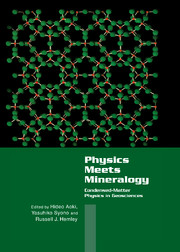Book contents
- Frontmatter
- Contents
- Preface
- List of Contributors
- Part I Introduction
- Part II Advances in Theoretical and Experimental Techniques
- Part III New Findings in Oxides and Silicates
- Part IV Transformations in Silica
- Chapter 4.1 Polymorphism in Crystalline and Amorphous Silica at High Pressures
- Chapter 4.2 Shock-Induced Phase Transitions of Rutile Structures Studied by the Molecular-Dynamics Calculation
- Chapter 4.3 Lattice Instabilities Examined by X-ray Diffractometery and Molecular Dynamics
- Chapter 4.4 Effect of Hydrostaticity on the Phase Transformations of Cristobalite
- Part V Novel Structures and Materials
- Part VI Melts and Crystal–Melt Interactions
- Subject Index
- Materials Formula Index
- Index of Contributors
Chapter 4.4 - Effect of Hydrostaticity on the Phase Transformations of Cristobalite
Published online by Cambridge University Press: 05 November 2011
- Frontmatter
- Contents
- Preface
- List of Contributors
- Part I Introduction
- Part II Advances in Theoretical and Experimental Techniques
- Part III New Findings in Oxides and Silicates
- Part IV Transformations in Silica
- Chapter 4.1 Polymorphism in Crystalline and Amorphous Silica at High Pressures
- Chapter 4.2 Shock-Induced Phase Transitions of Rutile Structures Studied by the Molecular-Dynamics Calculation
- Chapter 4.3 Lattice Instabilities Examined by X-ray Diffractometery and Molecular Dynamics
- Chapter 4.4 Effect of Hydrostaticity on the Phase Transformations of Cristobalite
- Part V Novel Structures and Materials
- Part VI Melts and Crystal–Melt Interactions
- Subject Index
- Materials Formula Index
- Index of Contributors
Summary
Cristobalite was compressed at room temperature up to 30 GPa under quasi-hydrostatic and nonhydrostatic conditions. The structure of the high-pressure phase differs completely, depending on the hydrostaticity of applied pressure. Under quasi-hydrostatic conditions, a structure very similar to that of stishovite was formed above ∼20 GPa, which can be quenched to ambient conditions. When this phase was heated to several hundred degrees centigrade under pressure, normal stishovite was formed. Under nonhydrostatic conditions, on the other hand, cristobalite transformed into the unidentified X-I phase at ∼15 GPa, in accordance with previous study. This X-I phase transforms into stishovite on heating to above 1000°C. The apparent compressibility of cristobalite also differs considerably, depending on the nature of applied pressure. The nature of the high-pressure phases formed by the room-temperature compression of cristobalite is discussed.
Introduction
Silica is one of the most intensively studied materials under a wide range of pressure and temperature conditions because of its importance in earth science as well as in material science. In spite of its simple chemical formula, many different polymorphs are formed, depending on the pressure and the temperature conditions. Moreover, recent room-temperature compression studies of various polymorphs clarified the formation of variety of metastable phases [1–5], and the situation is complicated. It is likely that the formation of some of the metastable phases is related to the nonhydrostatic nature of applied pressure. Here we report a new example of the formation of completely different high-pressure structures that depend on the hydrostaticity of applied pressure.
- Type
- Chapter
- Information
- Physics Meets MineralogyCondensed Matter Physics in the Geosciences, pp. 242 - 256Publisher: Cambridge University PressPrint publication year: 2000
- 2
- Cited by



